Fig. 6.1
Visual close inspection can direct the attention in different areas of the dental surface to identify the presence of initial demineralization and/or caries; white spots on molar fissures, that are indicative of progressive demineralization stage (black arrows) (Reprinted with permission from Olivi et al. [1])

Fig. 6.2
Visual close inspection shows the presence of dark spots, normally not associated with enamel demineralization; probing, x-ray, and LF diagnosis will give a more precise diagnosis
Even the periapical or bitewing intraoral x-rays cannot show initial enamel caries (grade I); the radiographs may instead be an important aid in the diagnosis of proximal caries when carious process extends in dentin (grade II and III).
Furthermore, caries risk patients that undergo clinical checks every 3–6 months are possibly exposed to an excessive radiation dose summation, and also pregnant women cannot receive x-rays, so exploring alternative noninvasive methods is necessary.
Lasers have many uses in preventive dentistry for the following purposes [1]:
-
Caries detection: laser fluorescence (LF) has been used for preoperative diagnosis of caries (DIAGNOdent, KaVo) in both primary and permanent teeth and as an intraoperative diagnostic tool (SIROInspect, Sirona).
-
Caries prevention: several infrared laser wavelengths have been used to provide increased enamel surface resistance to acid attack as experimental methods of caries prevention.
-
Sealants: erbium lasers irradiation are used to provide enamel surface modifications that are suitable for the application of pit and fissure sealants.
6.2 Laser for Caries Detection
Laser for caries diagnosis is the most widely investigated laser application in pediatric dentistry. In the last 15 years, several technologies were developed and investigated for different diagnostic purposes, including preoperative, intraoperative, and postoperative diagnosis. Laser fluorescence (LF) device using 655 nm light (DIAGNOdent and DIAGNOdent-pen; KaVo, Germany) is the more studied technology for preoperative diagnosis. Laser fluorescence at 405 nm (SIROInspect, Sirona, Germany) is a recent technology for intraoperative check of remaining carious tissue during excavation. The quantitative light fluorescence (QLF) uses a blue light, while the optical coherence tomography (OCT) uses near-infrared light at 1310 nm for preoperative diagnosis. Also the transillumination imaging diagnostic method uses laser light at 780 nm (DIAGNOcam) to produce proximal lesion images that are reported as comparable to bitewing radiographs.
6.2.1 Laser Fluorescence: The DIAGNOdent
Laser fluorescence (LF) is the most widespread laser diagnostic technology; it is a non-ablative laser device that emits a visible, red light at 655 nm.
When the light is directed towards the occlusal fissures of posterior teeth, it is easily transmitted through the enamel and is absorbed by a specific target. Effectively, bacteria by-products and porphyrins within the carious lesion absorb and simultaneously reflect a red fluorescent light that is detected and rated at a digital display and as an acoustic signal [2, 3] (Figs. 6.3, 6.4, and 6.5).
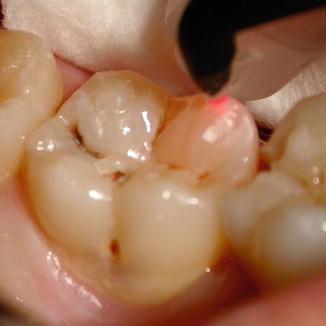
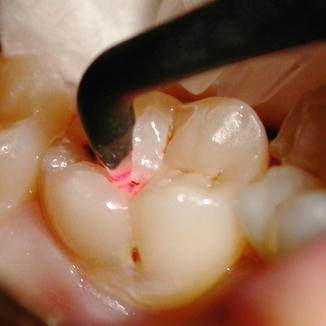
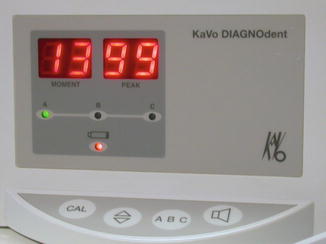

Fig. 6.3
LF detects with higher sensitivity and good specificity occlusal fissure caries; first the laser identifies the fluorescence value of healthy enamel (e.g., the enamel of a cusp)

Fig. 6.4
DIAGNOdent detects then the fluorescence of occlusal pits and fissures

Fig. 6.5
DIAGNOdent registers a numerical rate of the detection, reporting on the left the initial value of the healthy enamel and on the right the actual value detected (e.g., 99 is indicative of deep dentin caries)
Iwami et al. reported the relationship between bacterial infection of carious dentin and LF detection (polymerase chain reaction). The values of the LF increased as the bacteria detection rates increased, reinforcing the concept of the relationship between fluorescence values of caries and rates of bacteria by-products and porphyrins present [4]. Later on, Neuhaus et al. also reported that the quantitative measure of fluorescence of the tooth was related more to the presence of bacterial by-products than to the mineral loss subsequent to the development of a caries lesion [5].
Several studies compared different caries detection methods: visual inspection alone, visual inspection with magnification, bitewing x-ray, and laser fluorescence with different results.
Lussi and Francescut confirmed the very high reliability and the diagnostic validity (sum of sensitivity and specificity) of LF for occlusal caries detection and also reported it, as higher than bitewing radiography for proximal caries diagnosis in primary teeth. The authors concluded that LF could be used as an additional tool in the detection of occlusal caries in deciduous teeth and its good reproducibility should enable the laser device to monitor the caries process over time [6]. Another study reported that the reliability, predictability, and the reproducibility of the detection did not result as dependent on operator factor [7].
Olmez et al. (2006) evaluated the sensitivity and specificity of DIAGNOdent, visual examination, and bitewing radiography. Sensitivity measures the proportion of actual positives which are correctly identified as such (e.g., the percentage of decayed teeth who are correctly identified as having the condition). Specificity measures the proportion of negatives which are correctly identified as such (e.g., the percentage of healthy teeth who are correctly identified as not having the condition). Sensitivity and specificity for DIAGNOdent, visual examination, and bitewing radiography were 0.86/0.80, 0.69/1.00, and 0.36/1.00, respectively. The LF showed lower specificity than visual inspection and bitewing radiographs but on the contrary demonstrated significantly higher sensitivity for caries lesions than other conventional methods. Consequently, in case of doubtful diagnosis after clinical examination, LF having high sensitivity may be a useful adjunct to visual inspection with a high specificity to formulate the proper diagnosis of occlusal caries [8, 9].
Chu et al. compared three different methods for fissure caries detection in second permanent molars of young adults (visual examination, bitewing radiographs, and DIAGNOdent) and concluded that the combined approach of the LF and visual examination produced the better results [10].
Diniz et al. conducted an in vivo study to determine clinical cutoffs for a DIAGNOdent, a DIAGNOdent-pen, and a DIAGNOcam (fluorescence camera, FC) and to evaluate the clinical performance of these methods and conventional methods in detecting occlusal caries in permanent teeth. The International Caries Detection and Assessment System (ICDAS), the LF device, and the LF pen demonstrated good performance in helping detect occlusal caries in vivo. BW radiography and FC had the lowest performances in helping to detect the lesions. The study concluded that occlusal caries detection should be based primarily on visual inspection. Fluorescence-based methods may be used to provide a second opinion in clinical practice [11] (Figs. 6.6, 6.7, 6.8, 6.9, 6.10, and 6.11). Recently an in vivo study reported that caries lesions may be detected more accurately by laser fluorescence devices than by clinical visual inspection [12].
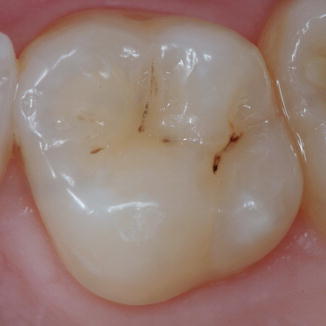
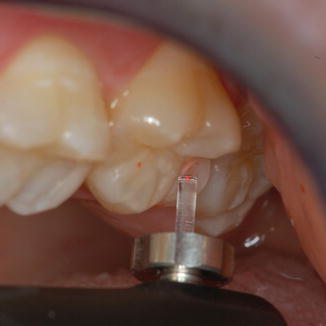
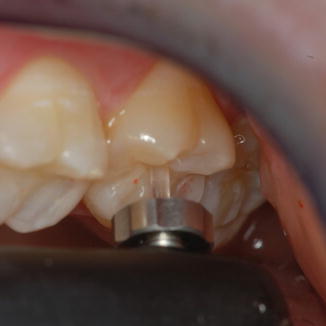
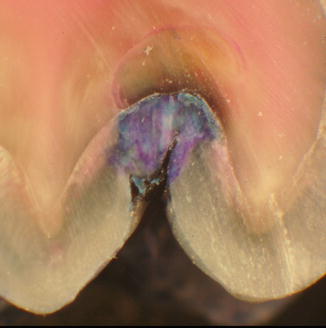

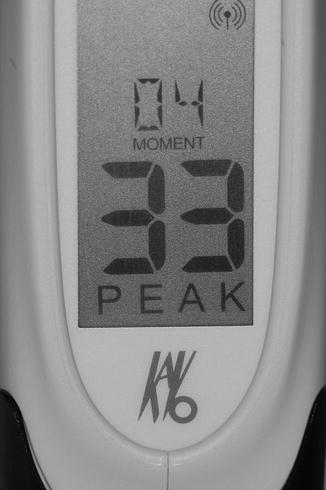

Fig. 6.6
Occlusal view of an upper permanent molar showing dark spots on pits and fissures (Courtesy of Prof. Vasilios Kaitsas, Italy)

Fig. 6.7
DIAGNOdent-pen first detects the healthy enamel fluorescence (e.g., the enamel of a cusp) (Courtesy of Prof. Vasilios Kaitsas, Italy)

Fig. 6.8
DIAGNOdent-pen detecting successively the fluorescence of enamel pits and fissures (Courtesy of Prof. Vasilios Kaitsas, Italy)

Fig. 6.9
Histology of an extracted molar, presenting similar very narrow fissure with apparently intact occlusal opening; enamel caries extending in dentin is difficult to identify (Courtesy of Prof. Vasilios Kaitsas, Italy)

Fig. 6.10
Minimal preparation of the fissures followed the combined visual and LF diagnosis (Courtesy of Prof. Vasilios Kaitsas, Italy)

Fig. 6.11
DIAGNOdent-pen detection related to Fig. 6.8 shows high value peak (Courtesy of Prof. Vasilios Kaitsas, Italy)
Laser fluorescence has been proposed also for monitoring and for appropriate management of dental caries in both primary and permanent molars.
An in vitro study by Mendes et al. reported that LF was neither able to detect the remineralization of incipient caries lesions of primary teeth nor to monitor the quantification of mineral loss in caries lesion development in primary teeth [13]. In a following study of the same group, Braga et al. reported that LF device performed better at the dentin threshold than at the enamel threshold; accordingly the study concluded that LF performed better in predicting the depth of the caries lesions (dentin caries) than the initial mineral loss (early enamel caries) [14].
Khalife et al. in an in vivo study also assessed the correlation between the depth and volume of caries and DIAGNOdent readings and concluded that the DIAGNOdent should be used only as an adjunct to the diagnosis and treatment planning process [15].
Also a more recent in vitro study by Bahrololoomi et al. concluded that LF is an appropriate method for detection of demineralization in smooth enamel lesions, but it was not so efficient in the detection of remineralization [16].
Besides occlusal caries detection performed with DIAGNOdent, a more recent version (DIAGNOdent-pen) has different tip shapes that enable an advanced proximal caries detection.
Novaes et al. compared the performance of various methods for proximal caries detection in primary molars. Both the LF pen and radiographic examination exhibited similar performance in the detection of cavitations on proximal surfaces of primary molars [17].
A recent study investigated in vitro a newly developed LED fluorescence device for proximal caries detection in comparison with DIAGNOdent-pen, bitewing x-rays, and visual inspection (International Caries Detection and Assessment System, ICDAS). Reliability data scored fair to moderate for the LED fluorescence device and good for bitewing radiography and laser fluorescence pen. However, it is the combination of different methods that gives better results, with association of visual inspection (ICDAS) and radiography yielding the best diagnostic performance at the dentine threshold [18] (Figs. 6.12, 6.13, 6.14, and 6.15).

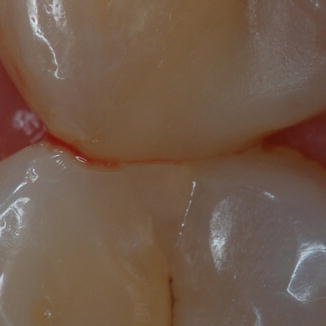
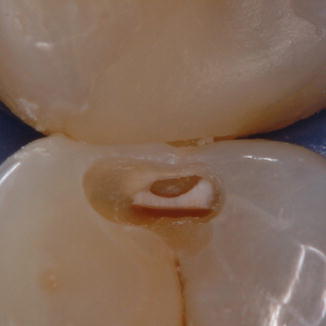
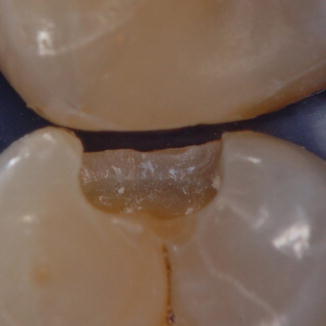

Fig. 6.12
LF detection of proximal surfaces in upper bicuspids using DIAGNOdent-pen and new tip-probe (chisel or conical) (Courtesy of Prof. Vasilios Kaitsas, Italy)

Fig. 6.13
Close proximal contact point among two bicuspids hides a proximal caries that is not visible at visual inspection or probing but is detected by LF (Courtesy of Prof. Vasilios Kaitsas, Italy)

Fig. 6.14
Initial opening of cavity from occlusal ridge shows the proximal caries (Courtesy of Prof. Vasilios Kaitsas, Italy)

Fig. 6.15
The cavity preparation is completed with conventional instruments (Courtesy of Prof. Vasilios Kaitsas, Italy)
Several studies investigated particular factors that could negatively influence the detection and must be kept in mind when combining the visual inspection and laser fluorescence detection.
The presence of brown or dark spots on fissures tends to overscore specific discolored areas of fissures, giving false positive detection [19].
The presence of plaque or toothpaste residual after teeth cleansing worsens the performance registering false readings [20, 21]; therefore, a careful preparation must precede the laser detection.
The laser reading under whitish dental sealants is unreliable due to inaccurate detection caused by intrinsic fluorescence of sealant material [22, 23]. However, it has been recently reported the possibility of monitoring the sealant procedure over time, when clear sealant is used [24].
To conclude this brief overview on laser diagnostic device guidelines, a study by Mendes et al. was included to give a complete and objective point of view. This study reported that adjunct methods of caries detection would not significantly improve the detection of primary molar lesions in comparison to visual inspection alone. The sensitivity, specificity, accuracy, and utility of diagnostic strategies were calculated. Simultaneous combined strategies increased sensitivities but decreased specificities, and, furthermore, no differences were observed in accuracy and utility, parameters more influenced by caries prevalence. The study concluded that present clinical guidelines should be re-evaluated [25]. In agreement with other studies [11, 18], it is personal opinion of the author that LF may be considered a valuable tool in combination to visual inspection, for caries detection as well as for longitudinal monitoring of caries and for assessing the outcome of preventive interventions during recall session in caries risk patients; LF allows to space out the x-ray examinations, so reducing the radiation dose summation (Tables 6.1, 6.2, and 6.3).
Table 6.1
Shows the DIAGNOdent values of occlusal fissures detection
|
DIAGNOdent™ readings according to the manufacturer
|
|---|
|
0–10 = Healthy tooth structure
|
|
11–20 = Outer half enamel caries
|
|
21–29 = Inner half enamel caries
|
|
30+ = Dentin caries
|
Table 6.2
Shows the DIAGNOdent-pen values of occlusal fissures detection
|
DIAGNOdent-pen™ readings according to the manufacturer
|
|---|
|
0–12 = Healthy tooth structure
|
|
13–24 = Outer half enamel caries (initial demineralization)
|
|
>25 = Inner half enamel caries (severe demineralization)
|
Table 6.3
Shows the DIAGNOdent-pen values of proximal detection
|
DIAGNOdent-pen™ readings according to the manufacturer
|
|---|
|
0–7 = Healthy tooth structure
|
|
8–15 = Initial demineralization
|
|
>16 = Severe demineralization
|
6.2.2 Laser Fluorescence: The SIROInspect™
Bacteria present in the infected carious dentin release metabolic products (porphyrins) that emit visible red fluorescence when lighted with a violet laser light (405 nm). Healthy tooth tissue differs in this respect by fluorescing green.
During caries excavation, one of the main problems is to avoid over-excavation saving healthy dentin to be removed. This is also more important when approaching deep caries for the possibility to create a pulp exposure (this topic is discussed in Sects. 7.7.2, 7.7.3, and 8.2.3). SIROInspect utilizes a patented technology (FACE, fluorescence-aided caries excavation) to illuminate the tooth cavity with violet light (405 nm). The advantage of intraoperative laser fluorescence technology is that the dentist can see which areas are carious and which are not, during excavation with a much greater degree of certainty than with dye detector or visual inspection or tactile feedback alone.
The light is delivered through a handy probe that presents an attachable filter fit and aligned on it (Fig. 6.16); this allows to filter out light with wavelengths below 500 nm, making the light with higher wavelengths to remain visible when the tooth is exposed to violet light. Few studies are present in literature on this topic.
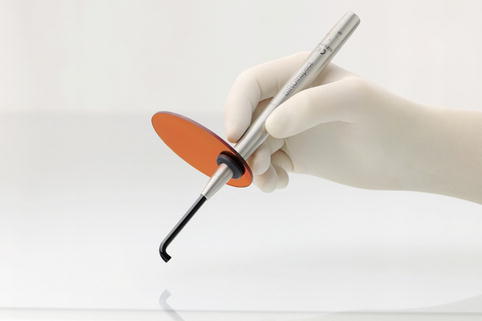
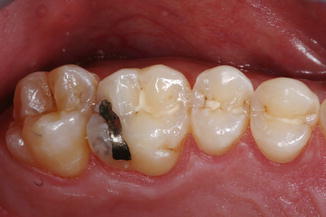

Fig. 6.16
SIROInspect with orange filter fit on the probe

Fig. 6.17
First upper quadrant of patients underwent to sealant application on bicuspids and molars 25 years before. The follow-up permits to check the sealing of the teeth and propose the amalgam removal (microcrack on distal wall)
The studies of Lennon et al. investigated the ability of fluorescence-aided caries excavation (FACE) to detect and remove infected dentin in primary teeth compared to conventional methods (tactile excavation criteria or a caries detector dye). The quantitative confocal microscopy and histologic investigations showed significantly less remaining infected dentin in FACE samples compared to conventional excavation, resulting in more effective excavation than conventional in removal of infected dentin [26, 27]. The author’s experiences are very positive on the utility of this device as an adjunct valuable instrument to perform minimal invasive cavity preparation.
6.3 Pit and Fissure Treatment
Most of the increased dental caries in children and adolescents are confined to pit and fissure surfaces of first molars. Sealants are one of the methods of primary prevention of dental oral diseases introduced in the 1960s, specifically to prevent fissure decays of posterior teeth [28–31]. Sealants fill the fissures of the dental surface closing the access into the deep enamel fissure of residual food and bacteria, preventing the possible carious process to begin, and therefore is a recommended preventive procedure for all the children.
A systematic review conducted in 2013 reported the efficacy of sealant in reducing caries up to 48 months when compared to no sealant groups; however, after a longer follow-up period the quantity and quality of the evidence is reduced [32]. Therefore follow-up sessions are fundamental for monitoring the conditions of teeth in young patients and to perform the prompt corrective measures (Figs. 6.18 and 6.19).
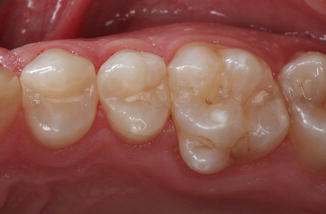
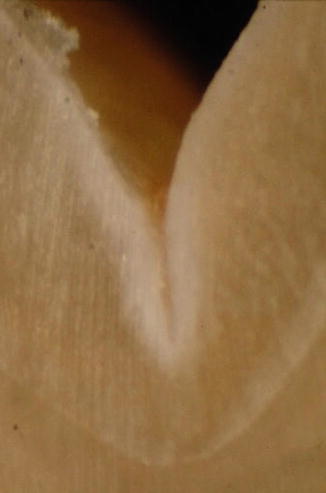

Fig. 6.18
Second upper quadrant of patients underwent to sealant application on first bicuspid, PRR on second bicuspid, and composite restoration on first molar 20 years before. The follow-up permits to check the sealing of the teeth and to diagnose proximal decay on second molar

Fig. 6.19
Buccolingual hemi-section of recently extracted third molar shows a very narrow anatomy of the fissure
Also topic fluoride varnishes have been extensively used as adjunct measures to prevent dental caries in caries risk patients. In 2013 an updated review confirmed the caries-inhibiting effect of fluoride varnish in both permanent and primary teeth; however, the quality of the evidence assessed was moderate [33].
In 2010, another systematic review compared the effectiveness of pit and fissure sealants with fluoride varnishes in the prevention of dental decay on occlusal surfaces. The results of the study reported evidence on the superiority of pit and fissure sealants over fluoride varnish application in the prevention of occlusal decay [34].
Accordingly, the application of sealant is the preventive procedure of choice for all the children. The application of fluoride varnishes could follow after some weeks of the application of sealant, to reinforce the smooth and proximal enamel areas that cannot be protected by the sealant. Fluoride varnish can be applied periodically every 3–6 months in case of high-risk patients with poor diet and bad oral hygiene habits and attitudes (see Sect. 2.4.1). It must be emphasized that fluoride inhibits the polymerization of the adhesive and composite systems and cannot be used before, but rather must follow the adhesive procedures.
Considering the different anatomy of different fissures, different pretreatment enamel techniques are used before the application of sealants Figs. 6.17, 6.18, 6.19, 6.20, 6.21, and 6.22:
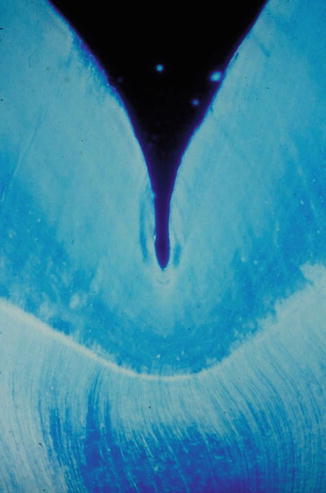
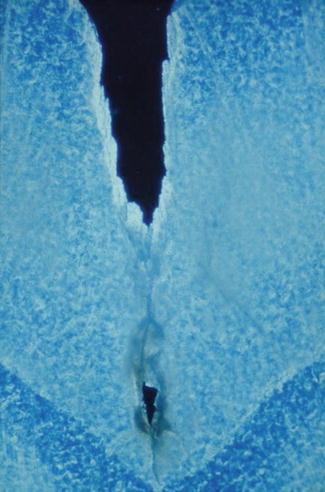
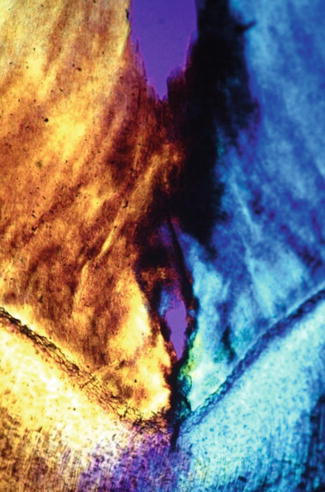

Fig. 6.20
Buccolingual hemi-section of extracted third molar shows a narrow healthy fissure

Fig. 6.21
Buccolingual hemi-section of extracted third molar shows a fissure with demineralization in depth very close to the enamel-dentin junction

Fig. 6.22
Buccolingual hemi-section of extracted third molar shows a fissure with demineralization in depth very close to the enamel-dentin junction
-
Noninvasive techniques using acid etching of the occlusal fissures
-
Noninvasive techniques using air abrasion followed by 37 % orthophosphoric acid etching of the occlusal fissures
-
Invasive techniques using diamond bur and high-speed drill to open the narrow fissures (fissurotomy), followed by the etching procedure with 37 % orthophosphoric acid.
When the occlusal surface presents small fissure and/or pit caries, a selective removal of any affected enamel and/or dentin without any preparation of the neighbor intact fissures is the treatment of choice. The prepared cavity is restored with composite resin, and a sealant is placed over the remaining intact fissures and pits, completing the minimally invasive procedure with a preventive procedure for the remaining healthy enamel. This technique was introduced by Simonson and is called preventive resin restoration (PRR) technique [35].
6.3.1 Laser Assisted Fissure Sealant (LAS)
Although there is evidence of sealants’ effectiveness, one major obstacle on its use is the concern of sealing over active caries lesions, and the decision of whether or not to place a sealant depends largely on the dentist’s assessment of the depth of the occlusal fossae (Figs. 6.23, 6.24, 6.25, and 6.26). Effectively pediatric dentists’ perception (visual examination and tactile perception) of fossa depth in permanent molars correlates moderately well with the actual fossa depth [36], so that clinical and anatomical consideration in combination with laser diagnostic values must be considered before the sealant procedure, because they condition both the clinical choice and the operative procedure, making the treatment plan more reliable (Figs. 6.27 6.28, 6.29, 6.30, 6.31, and 6.32). Anatomical and clinical considerations include the following:
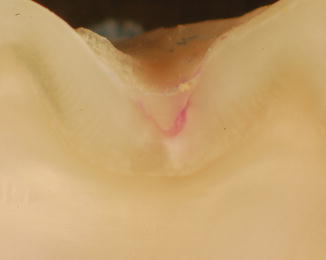
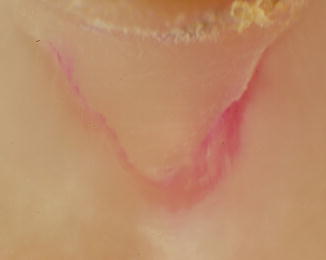
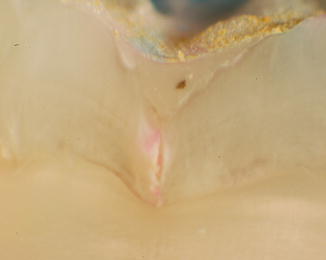
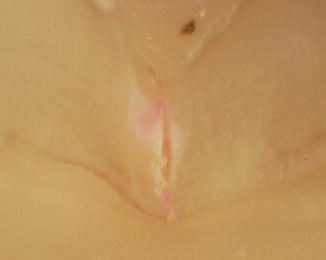
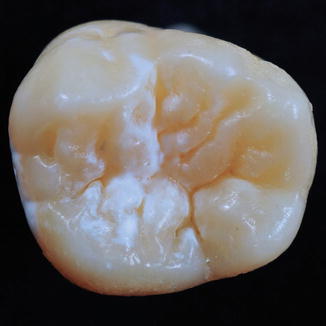
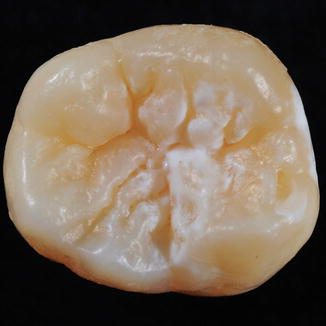
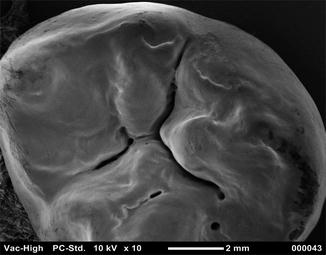
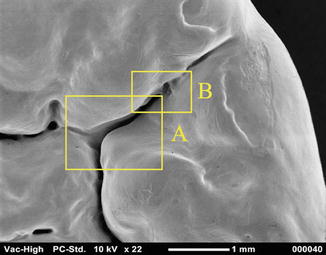
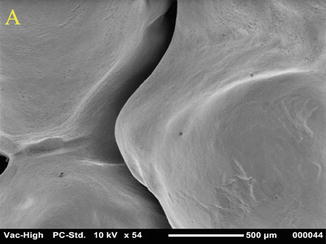
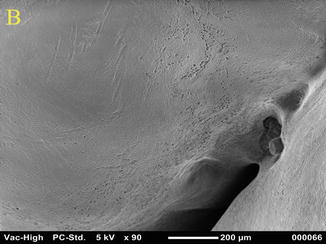

Fig. 6.23
Buccolingual hemi-section of extracted third molar following 24-h dye application. Image of fissure conditioned with orthophosphoric acid and sealed with no filled resin

Fig. 6.24
A magnification of the previous image shows presence of dye under the sealant as for initial enamel demineralization in the depth of the fissure; dentin is not involved in the process

Fig. 6.25
Buccolingual hemi-section of extracted third molar following 24-h dye application. Image of fissure conditioned with orthophosphoric acid and sealed with no filled resin

Fig. 6.26
A magnification of the previous image shows traces of dye under the sealant, in the depth of the fissure that also present initial demineralization of the enamel (clear area); dentin is not involved in the process

Fig. 6.27
Occlusal surface of extracted upper third molar presenting complicated fissure anatomy; also white demineralization areas are visible

Fig. 6.28
Occlusal surface of extracted lower third molar presenting complicated fissure anatomy; also white demineralization areas are visible

Fig. 6.29
SEM images (10×) of occlusal surface of upper third molar presenting complicated fissure anatomy

Fig. 6.30
SEM images (22×) of the same tooth show the influence of the magnification on the visual inspection. Three different areas (A, B) are deeply explored

Fig. 6.31
SEM images (54×) of the A area of Fig. 6.30. The narrow anatomy of the tooth is clearly visible by magnification

Fig. 6.32
SEM images (90×) of the B area of Fig. 6.30. The narrow and deep anatomy of the tooth explains the difficulty in cleaning the fissure before the sealant application
-
Age of the tooth eruption (just erupted or erupted for several months or years)
-
Visual perception of pit and fissure anatomy (deep, retentive)
-
Presence of dark or white spot on the fissures (demineralization)
-
LF values between 0–20 and 0–24 (DIAGNOdent or DIAGNOdent-pen*)
LF permits to diagnose the condition of the fissure and pits, addressing the procedure towards a preventive or therapeutical treatment (see Tables 6.1 and 6.2) (Figs. 6.33 6.34, 6.35, 6.36, 6.37, and 6.38).

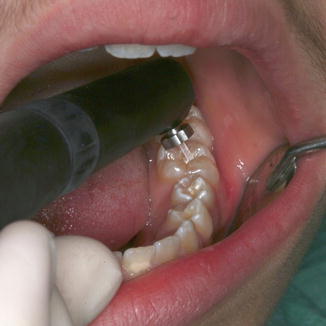
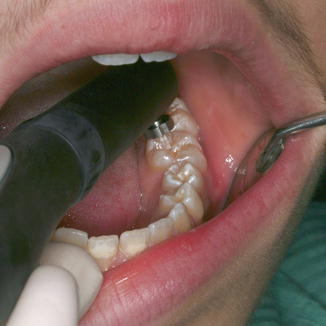
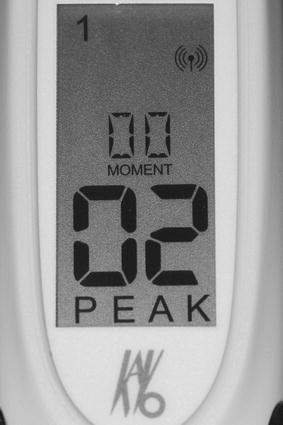
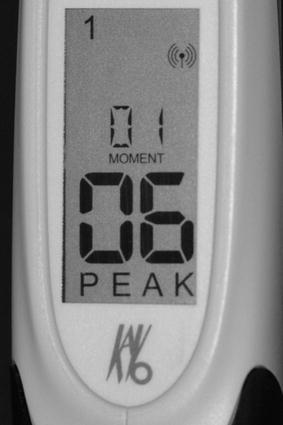
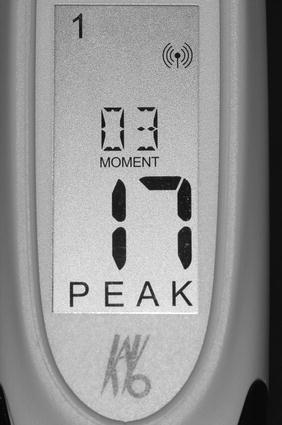

Fig. 6.33
Clinical intraoperative image shows apparently healthy second bicuspid and first molar of a 13-year-old boy, before sealant application

Fig. 6.34
DIAGNOdent-pen fluorescence detection of the enamel of mesial cusp

Fig. 6.35
DIAGNOdent-pen fluorescence detection of the fissures to assess the type of fissure treatment before sealant application

Fig. 6.36
DIAGNOdent-pen detection value of healthy enamel

Fig. 6.37
DIAGNOdent-pen detection value of the healthy fissure

Fig. 6.38
DIAGNOdent-pen detection value of the initially demineralized fissure
When fluorescence diagnosis is combined with erbium lasers (2780 and 2940 nm), it is possible to individualize (personalize) the treatment of the fissure. Erbium lasers can be used as:
-
Noninvasive technique for conditioning pretreatment of healthy pits and fissures before acid etching and sealant (LAS) (see Table 6.4)Table 6.4Suggested parameters for use laser assisted fissure sealant (LAS)Accurate diagnosis of the fissures: inspection and probing under magnification and fluorescence detection (value refers to DIAGNOdent-pen*, KaVo)Healthy fissuresFluorescence detection values: 0–10 (0–12*)Appropriate energy/fluence in order to cleanse and condition: 35 > 50 mJ–20 HzHigh air/water spray – short pulse duration – pulse rate may be increased if neededFissures with initial demineralizationFluorescence detection values: 11–20 (13–24*)Appropriate energy/fluence in order to cleanse, condition, and decontaminateDecontamination (first): 75 mJ–20 HzCleansing and conditioning: 35 > 50 mJ–20 HzHigh air/water spray – short pulse durationAccurate irradiation of fissures includes: correct focus, correct inclination, precise irradiation in order to avoid irradiation of the healthy enamel of ridges, and cusps using small diameter tip >400–600 μm tip. Close contact handpiece allows a better control and precision
-
Minimally invasive technique for decontamination and conditioning pretreatment of deep fissures or with initial demineralization before acid etching and sealant (LAS) (see Table 6.4) (Figs. 6.39, 6.40, 6.41, 6.42, 6.43, 6.44, and 6.45)
 Fig. 6.39Rubber dam application before the clinical procedure
Fig. 6.39Rubber dam application before the clinical procedure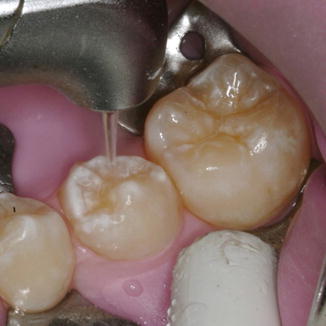 Fig. 6.40Er,Cr:YSGG laser irradiation of pit and fissures before sealant application: different parameters permit to differently condition or minimally prepare different areas, according to LF values detected
Fig. 6.40Er,Cr:YSGG laser irradiation of pit and fissures before sealant application: different parameters permit to differently condition or minimally prepare different areas, according to LF values detected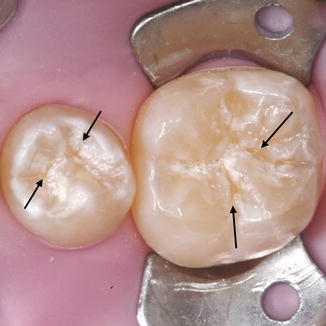 Fig. 6.41The black arrows show the deeper and wider area of fissures with higher LF detection values that were treated at higher fluence (ablation)
Fig. 6.41The black arrows show the deeper and wider area of fissures with higher LF detection values that were treated at higher fluence (ablation) Fig. 6.42Orthophosphoric acid etching following laser conditioning and ablation permits to improve the enamel pattern for bonding
Fig. 6.42Orthophosphoric acid etching following laser conditioning and ablation permits to improve the enamel pattern for bonding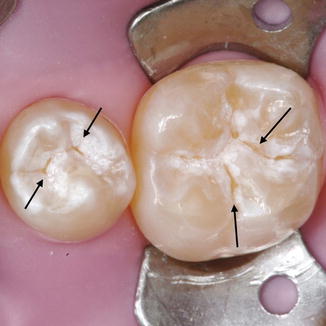 Fig. 6.43After acid etching the lased surface appears more clean and uniform before sealing. The black arrows show the exposed dentin after laser irradiation and more evident after orthophosphoric acid etching
Fig. 6.43After acid etching the lased surface appears more clean and uniform before sealing. The black arrows show the exposed dentin after laser irradiation and more evident after orthophosphoric acid etching
Stay updated, free dental videos. Join our Telegram channel

VIDEdental - Online dental courses


